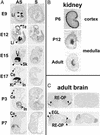The secretory proprotein convertase neural apoptosis-regulated convertase 1 (NARC-1): liver regeneration and neuronal differentiation
- PMID: 12552133
- PMCID: PMC298703
- DOI: 10.1073/pnas.0335507100
The secretory proprotein convertase neural apoptosis-regulated convertase 1 (NARC-1): liver regeneration and neuronal differentiation
Abstract
Seven secretory mammalian kexin-like subtilases have been identified that cleave a variety of precursor proteins at monobasic and dibasic residues. The recently characterized pyrolysin-like subtilase SKI-1 cleaves proproteins at nonbasic residues. In this work we describe the properties of a proteinase K-like subtilase, neural apoptosis-regulated convertase 1 (NARC-1), representing the ninth member of the secretory subtilase family. Biosynthetic and microsequencing analyses of WT and mutant enzyme revealed that human and mouse pro-NARC-1 are autocatalytically and intramolecularly processed into NARC-1 at the (Y,I)VV(V,L)(L,M) downward arrow motif, a site that is representative of its enzymic specificity. In vitro peptide processing studies andor Ala substitutions of the P1-P5 sites suggested that hydrophobicaliphatic residues are more critical at P1, P3, and P5 than at P2 or P4. NARC-1 expression is highest in neuroepithelioma SK-N-MCIXC, hepatic BRL-3A, and in colon carcinoma LoVo-C5 cell lines. In situ hybridization and Northern blot analyses of NARC-1 expression during development in the adult and after partial hepatectomy revealed that it is expressed in cells that have the capacity to proliferate and differentiate. These include hepatocytes, kidney mesenchymal cells, intestinal ileum, and colon epithelia as well as embryonic brain telencephalon neurons. Accordingly, transfection of NARC-1 in primary cultures of embryonic day 13.5 telencephalon cells led to enhanced recruitment of undifferentiated neural progenitor cells into the neuronal lineage, suggesting that NARC-1 is implicated in the differentiation of cortical neurons.
Figures






Similar articles
-
Implication of the proprotein convertase NARC-1/PCSK9 in the development of the nervous system.J Neurochem. 2006 Aug;98(3):838-50. doi: 10.1111/j.1471-4159.2006.03928.x. J Neurochem. 2006. PMID: 16893422
-
Statins upregulate PCSK9, the gene encoding the proprotein convertase neural apoptosis-regulated convertase-1 implicated in familial hypercholesterolemia.Arterioscler Thromb Vasc Biol. 2004 Aug;24(8):1454-9. doi: 10.1161/01.ATV.0000134621.14315.43. Epub 2004 Jun 3. Arterioscler Thromb Vasc Biol. 2004. PMID: 15178557
-
Processing of alpha4 integrin by the proprotein convertases: histidine at position P6 regulates cleavage.Biochem J. 2003 Jul 15;373(Pt 2):475-84. doi: 10.1042/BJ20021630. Biochem J. 2003. PMID: 12691605 Free PMC article.
-
The proprotein convertases are potential targets in the treatment of dyslipidemia.J Mol Med (Berl). 2007 Jul;85(7):685-96. doi: 10.1007/s00109-007-0172-7. Epub 2007 Mar 10. J Mol Med (Berl). 2007. PMID: 17351764 Review.
-
Inhibitors of proprotein convertases.J Mol Med (Berl). 2005 Nov;83(11):844-55. doi: 10.1007/s00109-005-0710-0. Epub 2005 Oct 8. J Mol Med (Berl). 2005. PMID: 16215768 Review.
Cited by
-
PCSK9-mediated degradation of the LDL receptor generates a 17 kDa C-terminal LDL receptor fragment.J Lipid Res. 2013 Jun;54(6):1560-1566. doi: 10.1194/jlr.M034371. Epub 2013 Mar 18. J Lipid Res. 2013. PMID: 23509406 Free PMC article.
-
PCSK9 Functions in Atherosclerosis Are Not Limited to Plasmatic LDL-Cholesterol Regulation.Front Cardiovasc Med. 2021 Mar 23;8:639727. doi: 10.3389/fcvm.2021.639727. eCollection 2021. Front Cardiovasc Med. 2021. PMID: 33834043 Free PMC article. Review.
-
Impact of Lowering Low-Density Lipoprotein Cholesterol with Contemporary Lipid-Lowering Medicines on Cognitive Function: A Systematic Review and Meta-Analysis.Cardiovasc Drugs Ther. 2021 Feb;35(1):153-166. doi: 10.1007/s10557-020-07045-2. Epub 2020 Aug 8. Cardiovasc Drugs Ther. 2021. PMID: 32770521
-
PCSK9 Inhibitors and Infection-Related Adverse Events: A Pharmacovigilance Study Using the World Health Organization VigiBase.Drugs Real World Outcomes. 2024 Sep;11(3):465-475. doi: 10.1007/s40801-024-00430-5. Epub 2024 Jul 2. Drugs Real World Outcomes. 2024. PMID: 38954190 Free PMC article.
-
Proprotein Convertase Subtilisin/Kexin Type 9 (PCSK9) Single Domain Antibodies Are Potent Inhibitors of Low Density Lipoprotein Receptor Degradation.J Biol Chem. 2016 Aug 5;291(32):16659-71. doi: 10.1074/jbc.M116.717736. Epub 2016 Jun 8. J Biol Chem. 2016. PMID: 27284008 Free PMC article.
References
-
- Steiner D F. Curr Opin Chem Biol. 1998;2:31–39. - PubMed
-
- Zhou A, Webb G, Zhu X, Steiner D F. J Biol Chem. 1999;274:20745–20748. - PubMed
-
- Seidah N G, Chretien M. Brain Res. 1999;848:45–62. - PubMed
-
- Docherty K, Steiner D F. Annu Rev Physiol. 1982;44:625–638. - PubMed
-
- Seidah N G, Mbikay M, Marcinkiewicz M, Chretien M. In: Proteolytic and Cellular Mechanisms in Prohormone and Neuropeptide Precursor Processing. Hook V Y, editor. Georgetown, TX: Landes; 1998. pp. 49–76.
Publication types
MeSH terms
Substances
LinkOut - more resources
Full Text Sources
Other Literature Sources
Molecular Biology Databases
Miscellaneous

